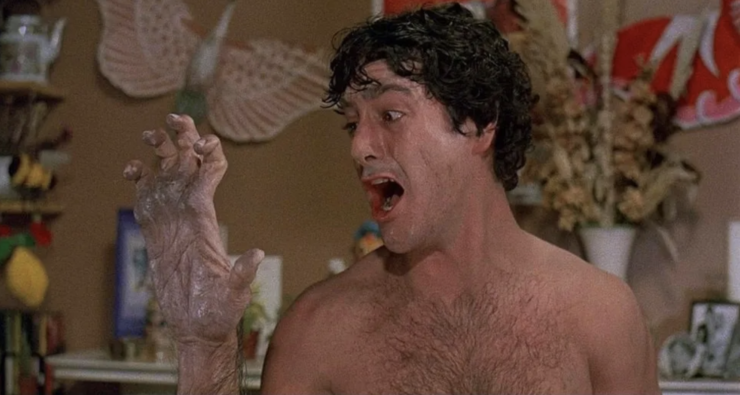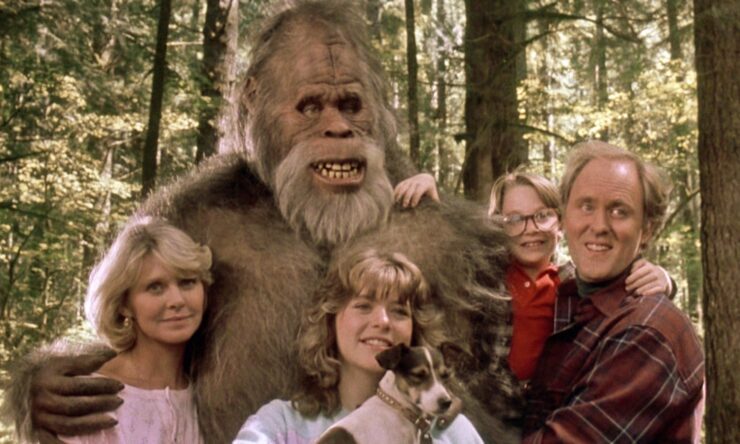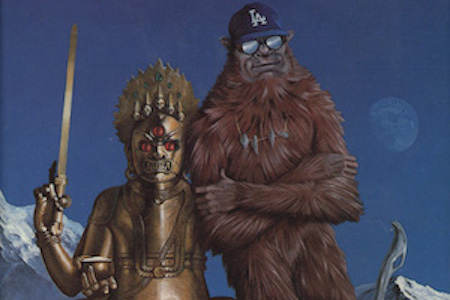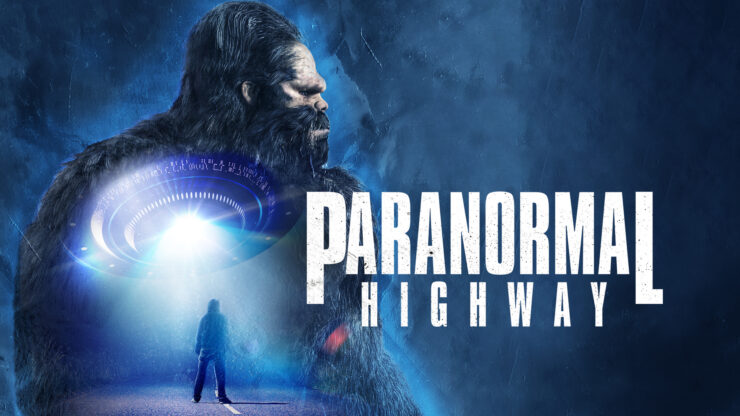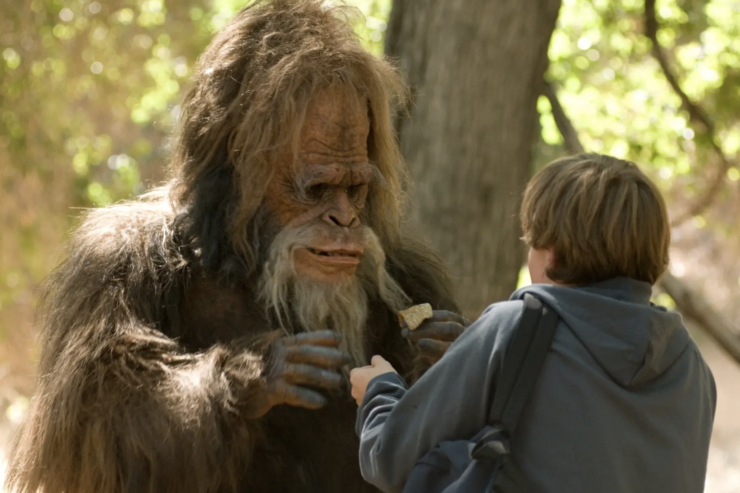John Landis’ 1981 werewolf film is an explicit homage to Lon Chaney, Jr and The Wolf Man. Its protagonist, David, is a fan, and he makes sure everyone around him knows it, especially his best friend and traveling companion, Jack.
We first encounter these two American bros backpacking across the moors in northern England, talking bro talk and being happily sexist about dull Debbie with the great body. As night draws in, they stop at a pub called The Slaughtered Lamb in the town of East Proctor. They receive anything but a warm welcome. There’s no food, nothing hot to drink but tea, and a wall of cold stares.
Being American, and being bros, they make a noble effort to break through the wall. Also being American and being bros, they completely trash that effort by asking, loudly and brightly, what is the meaning of the pentagram (or pentacle as they call it) crudely painted on the wall. Cue the first reference to The Wolf Man, in which this symbol is the mark of the werewolf.
The locals’ reaction is so categorically unfriendly that even these irrepressible bros know when to pick up their packs and leave. They receive one gift of sorts from the locals: “Stay on the road, stay off the moors.” To which one of them adds, “Beware the moon, lads.”
Once they’re gone, the barmaid protests that they really shouldn’t have been driven out. She’s overruled, after some argument. “It’s in God’s hands now,” intones one of the village leaders.
David and Jack, of course, almost immediately leave the road and strike out across the moors. A rainstorm closes in. And then they hear a wolf’s howl.
We’ve been well primed for what happens next. The chase is short and fierce. A shadowy creature with claws and fangs brings down Jack in gory ruin. David runs, but is caught and mauled—and suddenly there’s a mob of villagers. The monster is killed. David is wounded but alive.
As he lies half-conscious, he turns his head and sees not a monster but a naked, bloody, very dead man. Fade to black; fade to light again in a hospital bed, much patched and bandaged, with a pair of nurses in attendance, and a silver-haired doctor. He’s in London, they tell him, and he’s been unconscious for three weeks. His family has been notified, as have Jack’s next of kin. Jack, the doctor says gravely, is dead.
David soon discovers that it’s not as simple as that. He has ongoing dreams verging on nightmare, of running naked through woods and feeding on the raw flesh of a deer. Then Jack appears to him, mauled and mutilated as he was when he died, to inform him that he is now a werewolf, and Jack is undead. He is doomed to exist in limbo between life and death for as long as the line of the werewolf that killed him persists. The only way he can truly die is if David dies. David should kill himself before the full moon, end it all before any more people die.
David doesn’t believe him. He’s a hallucination, a manifestation of David’s grief and trauma.
Scotland Yard is investigating. The Inspector and his bumbling Sergeant are operating on the assumption that the two Americans were attacked by an escaped lunatic. It was an animal, David insists.
His life meanwhile takes a pleasant turn. One of his nurses, the beautiful Alex Price, invites him to stay with her, since he has nowhere else to go. This invitation comes with benefits which he is delighted to accept.
While Alex is at work, first David locks himself out of her flat, then after he gets back in through a window, Jack appears with another warning. Kill himself now, before the moon is full.
David ignores him—until night comes and brings the change. It’s a special-effects extravaganza. We get to see every phase, every shift, every hair as it sprouts. We fully appreciate how much pain David is in as his whole body cracks and twists and stretches and transforms.
And then we hear the wolf’s howl, and see the hunt. The nice couple going to dinner with friends. The businessman in the London Underground, fleeing in vain through the tunnels and up the stairs.
David wakes up in the morning, naked, in the wolf enclosure at the London Zoo. His escape is pure comic relief, involving a bemused child, a bouquet of balloons, a woman’s coat, and a bus queue that scrupulously ignores the weird American wearing a woman’s coat and nothing else.
While David has been out on the hunt, Nurse Alex and Dr. Hirsch have been discussing David’s case. David has told Alex about Jack and his warnings about becoming a werewolf, with further reference to the Chaney film. Naturally the doctor doesn’t believe that either Jack or the werewolf is real, but he is willing to acknowledge that David is severely traumatized and needs help.
To that end, the doctor drives up north to question the locals in East Proctor, while David makes his way home to Alex. He has no memory of the night, at all. One minute he was in the flat. The next, he was in the wolf enclosure.
There were six murders during the night, David and Alex learn from a cabbie. David, appalled, tries to get himself arrested, but the policeman he approaches dismisses his plea as a prank. Of course he’s not the monster who shredded half a dozen citizens.
Jack, who by now is much the worse for wear, lures David into a porn theatre in Piccadilly Circus. There, as a work of cinematic art titled “See You Next Wednesday” plays on the screen, Jack introduces him to the undead victims of last night’s killing spree.
Kill yourself, Jack says. Do it now. Before anyone else dies. The rest of the undead are happy to suggest ways in which David might do this.
But they’re too late. The change seizes David again. The undead vanish. He rampages through the theatre, terrorizing the staff, while outside, the police finally show up in force. They try to trap him in the theatre; he breaks loose, unleashing mayhem on Piccadilly Circus.
There’s blood, gore, multiple vehicle crashes, panic, chaos, and a last-minute escape down an alley. Alex goes after him. She tries to reach him by telling him she loves him.
We see the monster’s eyes soften for a moment. Then he drops in a rain of bullets, landing in human form, naked and dead. Alex weeps for him. The credits roll.
Buy the Book
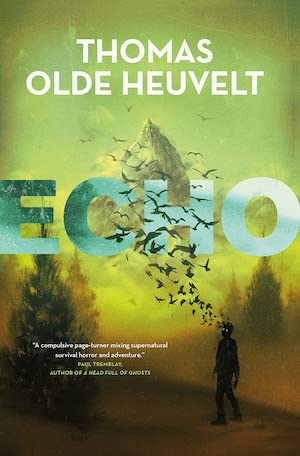

Echo
Compared to The Wolf Man and its predecessor, Werewolf of London, this is a surprisingly slight film. There’s a lot of explicit gore, and a lot of lovingly detailed special effects. The porn film near the end is a micro-masterpiece (and safely R-rated). What there’s not a lot of is character development or, all things considered, plot.
We do get to see in detail that the werewolf is more wolf than man, though still not exactly a wolf. The pentacle/pentagram is basically an excuse to mention the Chaney film. The full moon is not a thing in the Chaney film, though it’s become a trope by the 1980’s. The idea that a werewolf’s victims can’t die until he or the wolf he infected dies is a new wrinkle, and another excuse to show off the skills of the makeup department. One supposes that if the werewolf keeps on living, he’ll be followed around forever by a horde of decaying zombies.
Which would be an interesting take on the zombie genre. More interesting for me than the fleeting idea that a werewolf can only really be killed by someone he loves. Does that mean the werewolf who attacked Jack and David died at the hands of family?
The doctor’s trip to East Proctor doesn’t accomplish anything useful. It seems mostly to be a chance to show what an ass he is. Like the long, lingering sequences of blood, gore, and transformation, it fills up space without adding much to the story.
The Wolf Man is tragedy. An American Werewolf in London is dark comedy. The Ugly Americans, the wish-fulfillment relationship with the gorgeous nurse, the inept army of the law, the Greek chorus of undead, are played for a wince and a laugh. The film pays homage to Lon Chaney, Jr and his iconic character, with a distinct early-Eighties sensibility: wry, cynical, with a hint of slapstick.
Judith Tarr is a lifelong horse person. She supports her habit by writing works of fantasy and science fiction as well as historical novels, many of which have been published as ebooks. She’s written a primer for writers who want to write about horses: Writing Horses: The Fine Art of Getting It Right. She lives near Tucson, Arizona with a herd of Lipizzans, a clowder of cats, and a blue-eyed dog.










